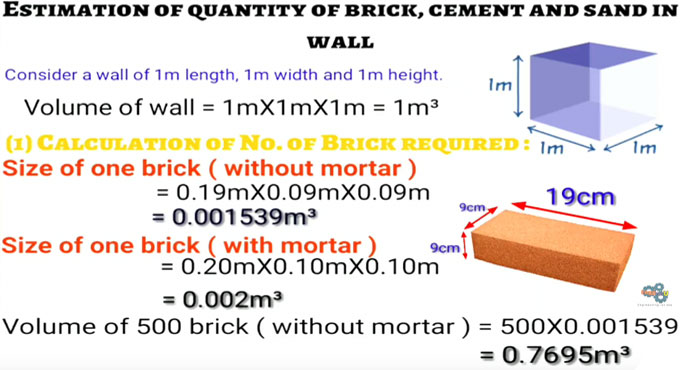TUTORIALS
Calculation of Quantity of Cement, Sand and Brick in Wall

In building construction, there is 75 percent brickwork and in 55% there is beam, column, slabs, and footings. Brickwork means making a wall or room. Bricks come in numbers while mortar is mixture of cement and sand. Cement comes in bag and one bag has a mass of 50 kg.
Suppose a wall having these dimensions - length = 1 m, width = 1 m and height = 1 m
Volume = 1 m x 1 m x 1 m = 1 m3
Estimation of quantity of bricks needed:
Dimension of 1 brick (“with no mortar in meter”) = 0.19 m x 0.09 m x 0.09 m = 0.001539 m3
Dimension of 1 brick (“with mortar in meter”) = 0.20 m x 0.10 m x 0.10 m = 0.002 m3
Quantity of bricks = wall volume/ 1 brick volume (with mortar) = 1 m3/0.002 m3 = 500 numbers
Estimation of mortar quantity:
500 brick Volume (“with no mortar”) = 500 x 0.001539 = 0.7695 m3
Wet Mortar Volume = wall volume – 500 bricks volume (‘with no mortar’) = 1 – 0.7695 = 0.2305 m3
Dry Mortar = 1.33 x Wet Mortar Volume = 1.33 x 0.2305 = 0.3065 m3 [subsequent to water addition, mortar volume lessens.]
Mortar ratio = 1:6, where 1 points to cement and 6 indicates sand
Cement volume needed = 1/(1 +6) x Dry Mortar Volume = 1/7 x 0.3065 = 0.0437 m3
Cement mass in kg = Density x Volume = 1440 x 0.0437 = 62.928 kg
One bag of cement mass = 50 kg
Quantity of cement bags required = 62.928/50 = 1.258 bags
Sand volume needed = 6/(1+6) x dry mortar volume = 6/7 x 0.3065 = 0.2627 m3 = 9.278 ft3
Lecturer: EnggForU

